Pnf approach stresses Study guides, Class notes & Summaries
Looking for the best study guides, study notes and summaries about Pnf approach stresses? On this page you'll find 6 study documents about Pnf approach stresses.
All 6 results
Sort by
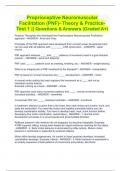
-
Proprioceptive Neuromuscular Facilitation (PNF)- Theory & Practice- Test 1 || Questions & Answers (Graded A+)
- Exam (elaborations) • 8 pages • 2024
-
Available in package deal
-
- $9.69
- + learn more
Proprioceptive Neuromuscular Facilitation (PNF)- Theory & Practice- Test 1 || Questions & Answers (Graded A+) Proprioceptive Neuromuscular Facilitation (PNF)- Theory & Practice- Test 1 || Questions & Answers (Graded A+) Physical Therapists who developed the Proprioceptive Neuromuscular Facilitation approach - ANSWER - Knott and Voss Principles of the PNF approach were developed from normal human development and can be used with all patients with ____ ____ CNS dysfunction. - ANSWER - upper...
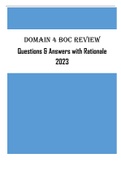
-
Domain 4 BOC Review Questions & Answers with Rationale 2023
- Exam (elaborations) • 69 pages • 2023
-
- $37.99
- + learn more
Domain 4 BOC Review Questions & Answers with Rationale 2023 c. 1. What does “extension lag” mean? a. Ability to only flex the knee b. Inability to fully backward bend (lumbar movement) c. One leg drags behind the other during gait d. Inability to fully extend the knee e. Inability to fully extend the hip 2. What is the best method of determining the recovery status of the hand and forearm after a flexor injury a. Use of a KT-1000 arthrometer b. Assessing the strength of...
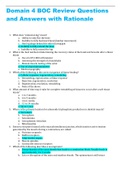
-
Domain 4 BOC Review Questions and Answers with Rationale
- Exam (elaborations) • 60 pages • 2023
-
- $17.49
- + learn more
Domain 4 BOC Review Questions and Answers with Rationale 1. What does “extension lag” mean? a. Ability to only flex the knee b. Inability to fully backward bend (lumbar movement) c. One leg drags behind the other during gait d. Inability to fully extend the knee e. Inability to fully extend the hip 2. What is the best method of determining the recovery status of the hand and forearm after a flexor injury a. Use of a KT-1000 arthrometer b. Assessing the strength of a handshake c....
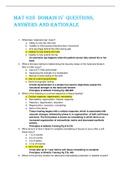
-
MAT 628 Domain IV Questions, Answers and Rationale
- Exam (elaborations) • 49 pages • 2023
-
- $18.49
- + learn more
MAT 628 Domain IV Questions, Answers and Rationale 1. What does “extension lag” mean? a. Ability to only flex the knee b. Inability to fully backward bend(lumbar movement) c. One leg drags behind the other during gait d. Inability to fully extend the knee e. Inability to fully extend the hip An extension lag happens when the patient cannot fully extend his or her knee 2. What is the best method of determining the recovery status of the hand and forearm after a reflex injury? a. ...
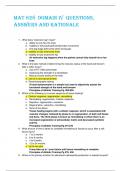
-
MAT 628 Domain IV Questions, Answers and Rationale
- Exam (elaborations) • 49 pages • 2023
-
- $17.69
- + learn more
MAT 628 Domain IV Questions, Answers and Rationale 1. What does “extension lag” mean? a. Ability to only flex the knee b. Inability to fully backward bend(lumbar movement) c. One leg drags behind the other during gait d. Inability to fully extend the knee e. Inability to fully extend the hip An extension lag happens when the patient cannot fully extend his or her knee 2. What is the best method of determining the recovery status of the hand and forearm after a reflex injury? a. ...
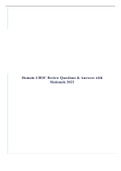
-
Domain 4 BOC Review Questions & Answers with Rationale 2023
- Exam (elaborations) • 63 pages • 2023
-
- $25.00
- + learn more
Domain 4 BOC Review Questions & Answers with Rationale 2023 c. 1. What does “extension lag” mean? a. Ability to only flex the knee b. Inability to fully backward bend (lumbar movement) c. One leg drags behind the other during gait d. Inability to fully extend the knee e. Inability to fully extend the hip 2. What is the best method of determining the recovery status of the hand and forearm after a flexor injury a. Use of a KT-1000 arthrometer b. Assessing the strength of a handshake c. Manual...

How much did you already spend on Stuvia? Imagine there are plenty more of you out there paying for study notes, but this time YOU are the seller. Ka-ching! Discover all about earning on Stuvia


